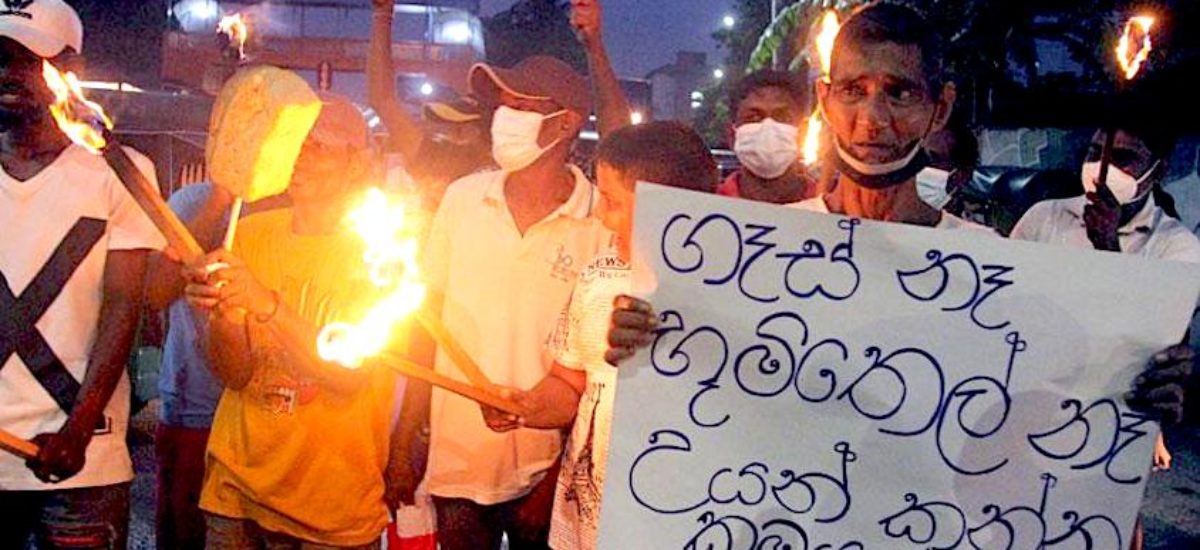Photo courtesy of Sri Lanka News
Last week witnessed the coming to the fore of the deep divisions within the governing alliance as President Gotabaya Rajapaksa sacked two Cabinet Ministers, Wimal Weerawansa and Udaya Gammanpilla, and laid bare the internal disquiet and dissent within the government, which had been brewing for a while but downplayed by the media until the political explosion. Concurrently, the 11 other minor political party allies of the government also parted ways with Minister Vasudeva Nanayakkara stating that he will neither attend cabinet meetings nor go to his ministry and the other parties vowing that their common political journey with the Rajapaksas and the SLPP is all but over; the government’s intra party relationships have ruptured.
The issue at stake is the political economy
Watching the current situation unfold from the spectator stands as it were, one gets a strange sense of deja vu. A populist president, elected with an overwhelming mandate, so mismanages the economy that even his own constituency of the majority ethno-religious community comes to accept that their interests are just not served through the combination of poor governance and weak economic management but very large doses of ethno-nationalism, disguised as patriotism. The classic formulae for regime change are a divided government and an united opposition. When the government splits the opposition, just sniffing political blood, makes the extra effort to unite. A similar scenario existed in 2014. Earlier, the departure of the JHU, from the administration of Mahinda Rajapaksa was the first public rupture in that Rajapaksa administration. In the present administration, the departure of Wimal Weerawansa and Udaya Gammanpilla signals the same rupture.
The Rajapaksas rid themselves of majoritarian nationalist spokesmen
Interestingly on both occasions for the two Rajapaksa administrations, the break comes from its right wing as Sinhala nationalists who explored the non-existent political space of being more ethno-nationalist than the ruling Rajapaksas were forced to make their exit. On both occasions, the exit preceded or coincided with the rise of other non-party political organizations pushing an anti-minority – especially anti-Muslim – agenda. In 2011/12, the effort was in the civil society-NGO space and of course in the current dispensation, the same personality heading an innocuously named presidential task force, more clearly positioned within the state. But what this rupture does is politically significant. The near monopoly of the Sinhala nationalist vote and of uniting it for a political victory, as President Gotabaya Rajapaksa correctly claimed during his presidential victory speech at Anuradhapura, has in less than three years come apart. The mainstream media claim that the president, prime minister and finance minister were not unanimous in their decision to sack the duo. While it is undoubtedly correct that the Rajapaksas and the SLPP command more support than Wimal’s NFF and Udaya’s PHU, the duo will cause more political damage as regime dissidents than any assistance they gave as regime supporters. Fighting with your allies is political suicide. Look at Maithripala Sirisena and Ranil Wickremesinghe; their infighting and disunity ended their administration and their political careers at the apex.
A divided government loses its super majority and the causes are economic
The rupture within the government has effectively eliminated the government’s two thirds majority in parliament. The number of minority MPs it can buy over are now limited having effectively emptied the shelves or rather the benches right after the general elections, so that option does not compensate for breaking with its allies. Various routine, non-controversial bills may pass with large majorities but the SLPP administration does not have the political clout or ability to push through its will quite so ham-handedly.
A recent Verite Research poll put the government’s approval rating at about 10% percent; an entirely believable number given the complete collapse of public services brought on by ruinous policies, very similar to the SLFP’s economic mismanagement of 1970-77. But this is worse and the people’s expectations and aspirations are higher, so the political price to pay and the vengeance of the electorate at the polls will be severe. Governments don’t lose public support over a fuel shortage but bring about a continuous combination of gas, milk powder, diesel, raw materials and foreign exchange shortages and five to seven hours a day of power cuts combined with soaring inflation, rising unemployment, declining agricultural yields and collapsing rural incomes due to the government’s fertilizer fiasco means that the SLPP will experience at the polls what the UNP did in 2020 – its effective elimination.
This brings us to the relatively new alternative government of Opposition Leader Sajith Premadasa and his Samagi Jana Balawegaya (SJB). The SJB has not been quite as inactive as is made out to be by the same media that downplayed the government’s long running divisions until they exploded. The SJB has been doing a series of pocket meeting type gatherings within Covid-19 prevention guidelines, perhaps prompting the governing party’s Anuradhapura rally and Sajith has been drawing increasing crowds. A recent political cartoon in a leading daily broad sheet was quite telling. It showed a picture of a sinking ship and rats jumping ship with the faces of the eleven leaders of the political parties that broke with the government superimposed on the rats. The proverbial rats deserting the sinking ship. The issue is that the ship is sinking. It is necessary to ensure that the country doesn’t go down with it.


